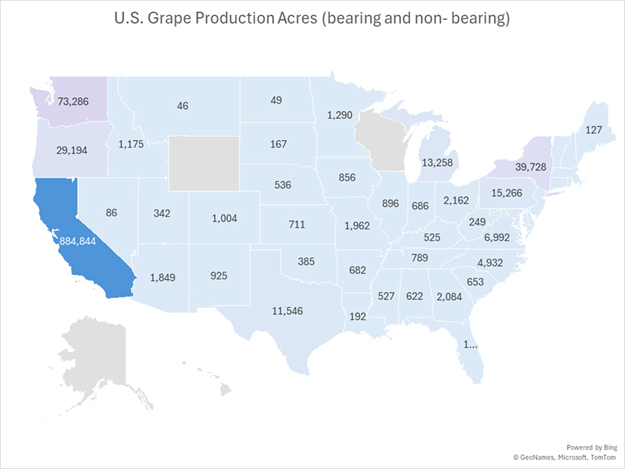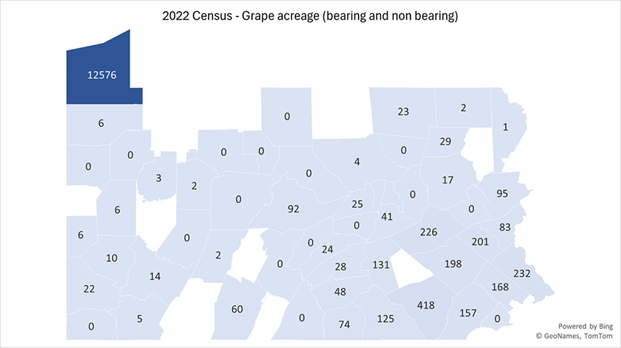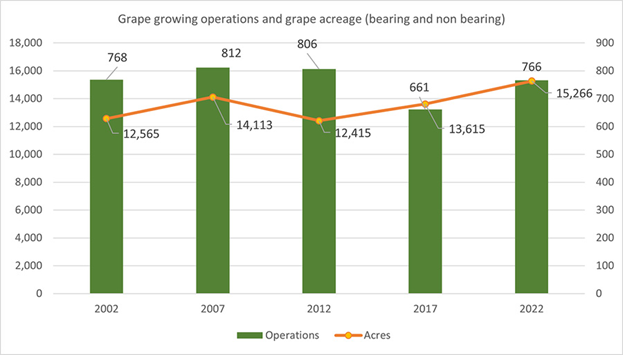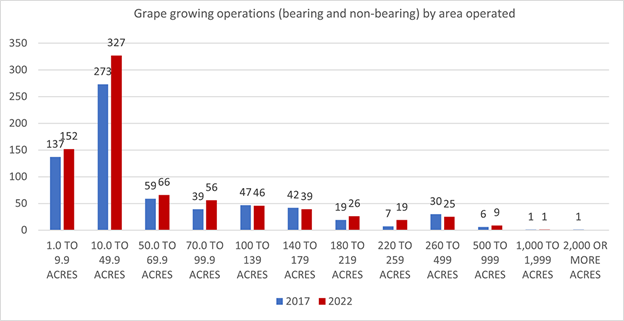Claudia Schmidt, Assistant Professor of Marketing and Local/Regional Food Systems
Andrew Holden, Business Management Extension Educator
Pennsylvania is Ranked Fifth in the Nation for the Number of Acres
According to the 2022 Census, U.S. grape production encompasses 1,108,161 acres of bearing and non-bearing vineyards and is managed by 27,951 operations. The total grape production volume reached approximately 5.96 million tons, with an average yield of 6.63 tons per acre.
California stands out with 884,844 acres, surpassing all other states combined. Washington ranks second with 73,286 acres. New York and Oregon contribute smaller shares with 39,728 and 29,194 acres, respectively, while Pennsylvania ranks fifth with 15,266 acres.
Map of US grape production acres by state.
Grape Production in Pennsylvania
The only publicly available source for grape production trends in Pennsylvania is the agricultural census, which is conducted every four years. The National Agricultural Statistical Services (NASS) stopped collecting annual production and utilization data for a couple of commodities (for example, bell pepper, cantaloupe, and grapes) in states that are not “major” producers.
For grapes, NASS stopped producing annual grape production statistics in 2018 in Pennsylvania. Before that, the data showed how many tons of wine grapes, including the average price per ton, and how many tons of sweet juice and other grapes were produced. For several years, annual data were only collected for California and Washington. However, in 2024, New York and Oregon’s annual data were collected again. If we go further back, until 2011, NASS produced a detailed ‘Vineyard and Orchard Acreage Survey’, breaking down the production between Concord, V. vinifera, native grapes, and hybrids. The following sections will show trends we can capture with the available data. If not mentioned otherwise, all data are retrieved from the agricultural census.
Grape Production in Pennsylvania at the County Level
NASS lists the number of producers that receive income from grape sales per county. The map below shows the concentration of grape growers per county in Pennsylvania. The distribution of grape-producing operations and the type of grape production in Pennsylvania varies significantly by county. Most vinifera growers are concentrated in the southeastern region of Pennsylvania, while most concord grape production occurs in Erie County, which spans both the Pennsylvania and New York sides. Erie County dominates grape production in Pennsylvania, with 180 operations managing 12,576 acres, far surpassing other counties. Lancaster County follows with 65 operations on 418 acres, while Bucks County has 37 operations managing 232 acres. Notably, counties like York, Chester, and Berks show smaller scales, with operations ranging from 24 to 28 and acreage staying below 200.
Hence, Erie’s grape acreage is almost 30% of the entire Lake Erie AVA and over 80% of all grapes grown in the state. Of these 12,000+ acres, most are Concord grapes used for juice, jelly, and wine. Welch’s largest production facility is in Erie County, in northwestern PA. The Concord grape belt extends east from Erie County across the state line into New York. While we lack specific data comparing the production of Concord and Vinifera grapes, it is noteworthy that the four top-selling wines in Pennsylvania are made from Concord grapes. These include Clarion River Red (a blend with Niagara) and Clover Hill Vineyards & Winery’s Concord (PLCB annual report for 2022/23).
2022 Census, number of grape-growing operations in Pennsylvania by county
2022 Census, number of grape-growing acreage in Pennsylvania by county
Production Trends
The graph below shows the number of grape growing operations (green bars) and the area of grapes grown, in acres (orange line). Grape production trends in Pennsylvania from 2002 to 2022 show notable fluctuations in both acreage and the number of operations. Acreage increased overall, rising from 12,565 acres in 2002 to 15,266 acres in 2022. However, the number of operations has been more variable. After peaking at 812 operations in 2007, the count dropped to 661 in 2017 before rebounding to 766 in 2022. These trends suggest consolidating grape production into fewer, larger operations, reflecting shifts in industry structure while maintaining an overall upward trajectory in production scale.
Bar chart showing grape-growing operations and acreage
Between the 2017 and 2022 censuses, vineyard sizes in Pennsylvania saw growth in select categories, such as an increase in vineyards measuring 10 to 49.9 acres (from 273 to 327) and 70 to 99.9 acres (from 39 to 56). Smaller vineyards of 0.1 to 0.9 acres also grew from 137 to 152 operations, while larger operations of 500 to 999 acres slightly increased from 6 to 9. However, some mid-sized categories showed slight declines or stability, such as the 100- to 139-acre range decreasing from 47 to 46, and 260 to 499 acres dropping from 30 to 25. Again, these trends suggest a diversification of vineyard operation sizes, with modest expansions in small and mid- sized vineyards
Bar chart showing grape-growing operations by area operated for 2017 and 2022
Lake Erie Grape Belt Production Trends
By examining Erie County’s data, the data shows that the predominantly concord/juice grape producing region trends differ slightly from the rest of the state over the last 20 years. Being home to 80% of the state’s grape acreage, examining these trends can show what direction the largest sector of grape acreage is heading. From 2002 to 2022, the number of grape farms in Erie County went from 230 to 180 (a 22% decrease) while the statewide data shows a loss of only 2 producers (768 to 766) in the same time frame. Meanwhile, Erie County saw an acreage increase from 11,171 acres of grapes in 2002 to 12,576 acres (an all-time high in the past 20 years) in 2022. The rest of the state also saw a similar increase in grape acreage from 2002 to 2022, going from 1,394 to 2,699. With increased acreage and decreased farmer numbers, average producer size has grown significantly in Erie County over the past 20 years. These trends follow the trends of neighboring New York’s ‘Concord Belt’ counties like Chautauqua, NY.
This article has been reviewed by Megan Luke, Penn State Extension, Viticulture & Tree Fruit Educator.





